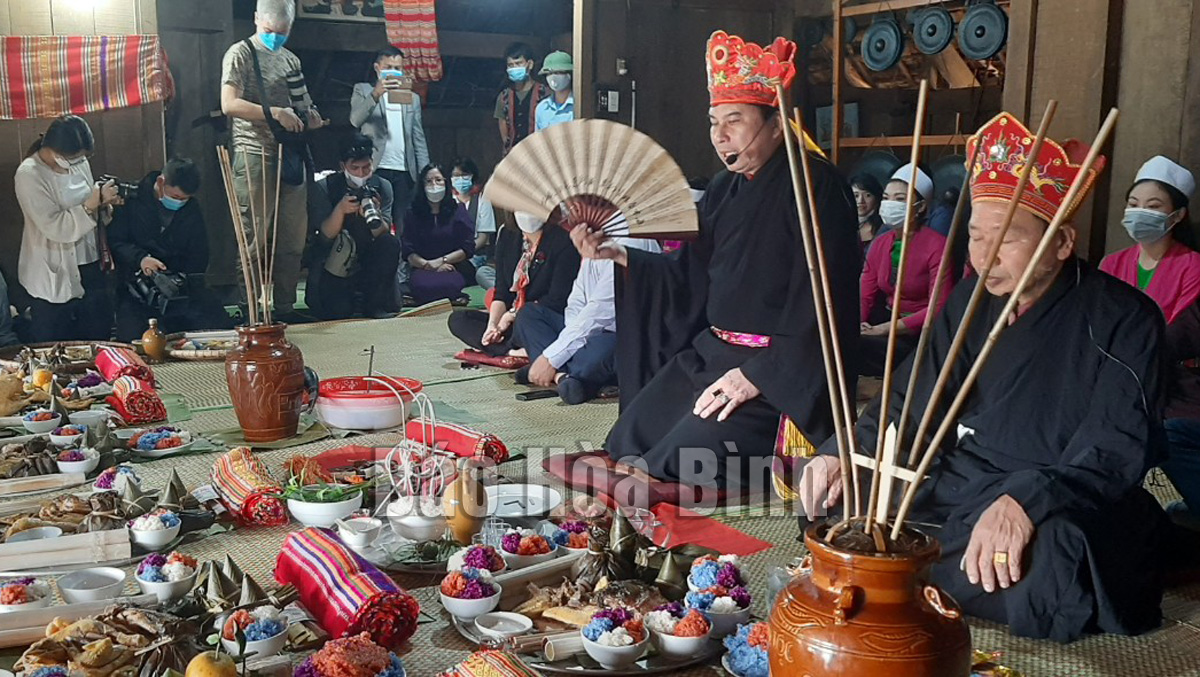
(HBO) - The house-cooling ceremony is one of the traditional spiritual and cultural rituals of the Muong people in Hoa Binh province. Its purpose is to pray for good crops, good health, good luck, and repel bad luck and risks. Therefore, most families in the Muong community organise the ritual at the beginning of the year to pray for peace. By cutting down unsound customs, the house-cooling ceremony has become a typical cultural feature and an indispensable activity in many Muong families every spring.

The house-cooling ceremony of the Muong ethnic group
in Hoa Binh recreated and performed at the Vietnam National Village for Ethnic
Culture and Tourism (Dong Mo, Son Tay, Hanoi).
Having spent time researching and reacting the ceremony at
the Cultural Village, Meritorious Artisan Bui Thanh Binh, Director of the Muong
Cultural Heritage Museum in Hoa Binh city, shared that the original meaning of
the word "mat nha" in the Muong language is to cool the family down,
make family members healthy and peaceful, and drive back bad things and bad luck.
Therefore, Muong people often hold the ritual on the first days of the year or
when someone in their home is sick or experiences bad luck.
In the past, the ceremony was arranged quite expensively, as
shamans requested house owners to prepare up to 11 trays, including nine big
and two small trays. The big trays were offered to the local tutelary, and god
of the soil.
In addition, homeowners had to prepare a
"community" tray with all kinds of dishes placed near the main door.
The Muong people believe that bad things happen because of ghosts. Therefore,
when the house held a feast to offer to the gods, they did not forget to offer
sacrifices to sentient beings. As the tray was placed at the main door, the
hungry ghosts were invited by the shaman to eat the dishes. After that, the
shaman made spells so that evil spirits did not return to disturb the
householder.
At present, implementing a civilised lifestyle during
festivals under the guidance of the Ministry of Culture, Sports and Tourism,
and in order to preserve and promote the typical culture of the Muong ethnic
group, the house-cooling ceremony has been simplified. There need three-five
trays of offerings for gods and ancestors, and one for sentient beings./.
With an increasingly vibrant and widespread emulation movement aimed at building cultured residential areas and cultured families, Yen Thuy District has been making steady progress toward improving both the material and spiritual well-being of its people, while fostering a civilized, prosperous, beautiful, and progressive community.
Once lacking recreational spaces and community facilities, Residential Group 2 in Quynh Lam Ward (Hoa Binh City) has recently received attention for the construction of a new, spacious, and fully equipped cultural house. The project followed the model of state support combined with public contributions in both labor and funding.
The "All people unite to build cultural life" movement, which has been effectively integrated with Kim Boi district’s socio-economic development goals, is fostering a lively spirit of emulation across local residential areas, hamlets, villages, public agencies, and enterprises. In addition, through the initiative, traditional cultural values are being preserved and promoted, while community solidarity and mutual support in poverty reduction and economic development are being strengthened.
A working delegation of the Hoa Binh provincial People’s Committee led by its Permanent Vice Chairman Nguyen Van Toan on June 11 inspected the progress of a project to build the Mo Muong Cultural Heritage Conservation Space linked to tourism services in Hop Phong commune, Cao Phong district.
Born and growing in the heroic land of Muong Dong, Dinh Thi Kieu Dung, a resident in Bo town of Kim Boi district, in her childhood was nurtured by the sweet lullabies of her grandmother and mother. These melodies deeply imprinted on her soul, becoming an inseparable part of her love for her ethnic group's culture. For over 20 years, this love for her hometown has driven Dung to research, collect, and pass down the cultural values of the Muong people to future generations.
In the final days of May, the Ethnic Art Troupe of Hoa Binh Province organized performances to serve the people in remote, mountainous, and particularly disadvantaged areas within the province. These were not just ordinary artistic shows, but they were the meaningful journeys aimed at spreading cultural values, enhancing the spiritual life of the people and contributing to the preservation of ethnic minority cultural identities.



